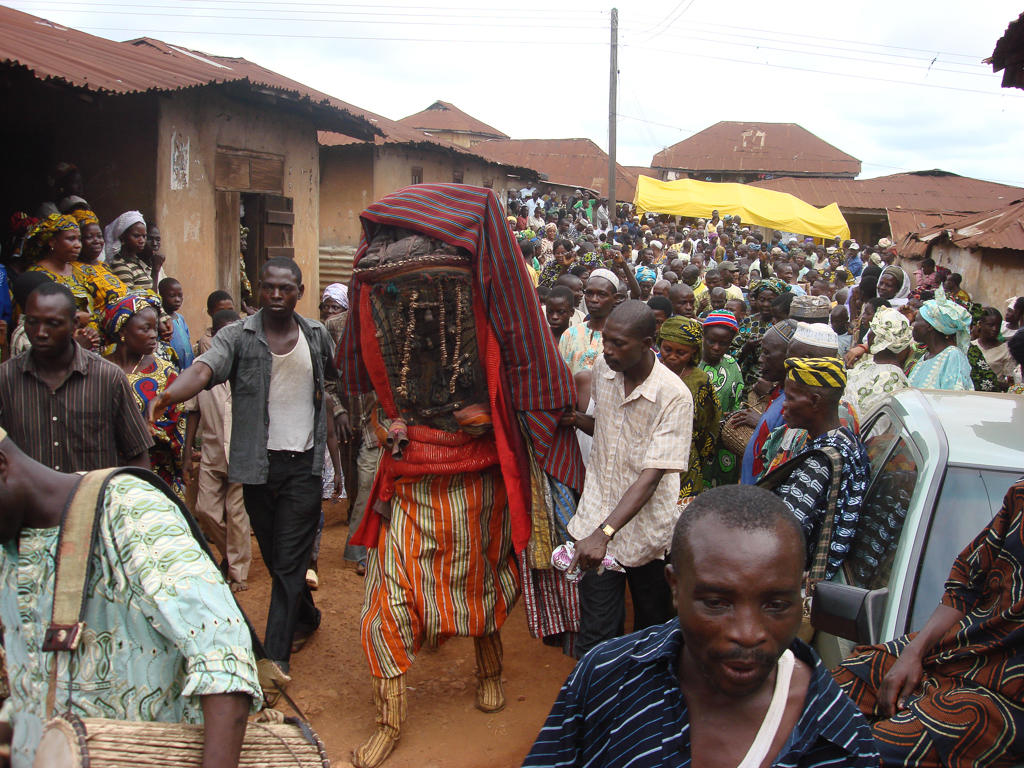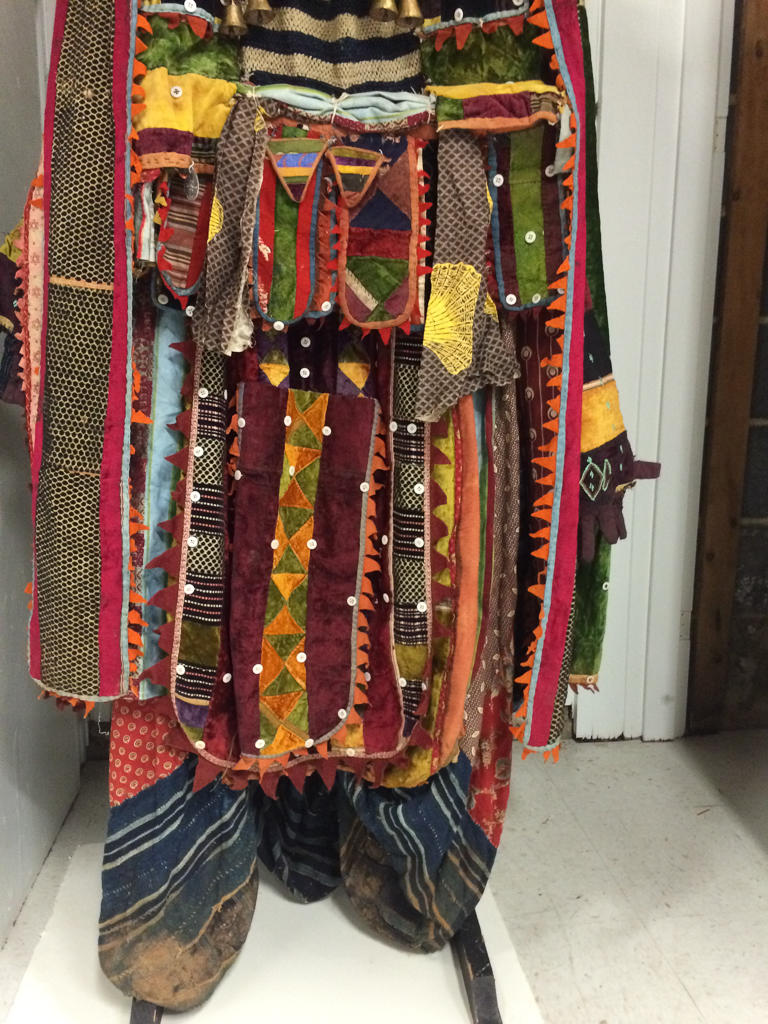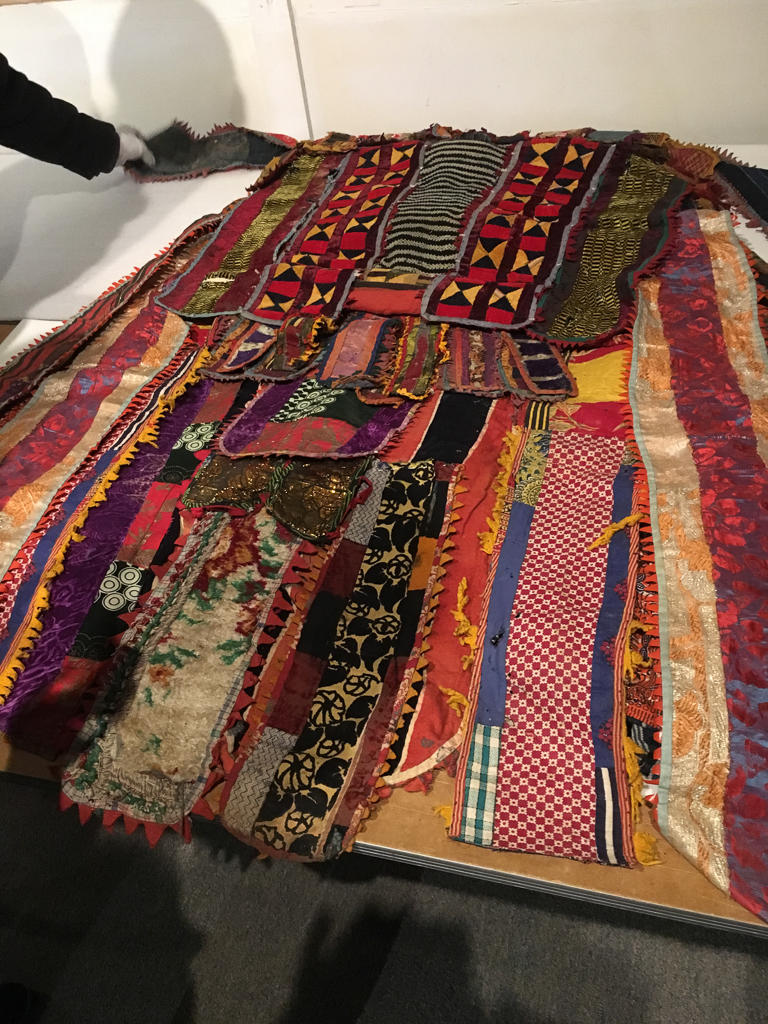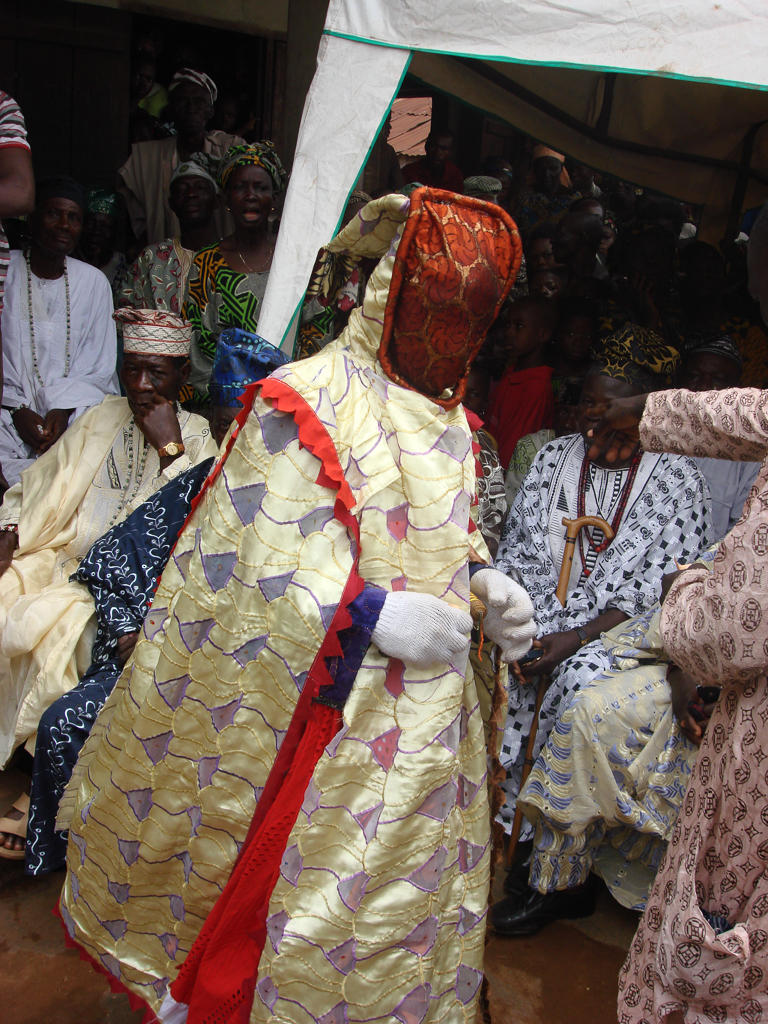Egungun costumes are usually created from a wide variety of carefully chosen fabrics ranging from exquisite samples of local handwoven aso ofi to exotic fabrics imported from around the globe. The choices represent the best that money can buy, and include velvet (aran), damask, silk, lace, and cotton, including ankara, or Africanized Dutch wax prints. The fabrics are arranged into strips or panels of intricately decorated sashes—ooja—like those used by women in tying babies on their backs, and at the same time referencing the mythic history of Egungun and the collaboration between Eesa Ogbin Ologbojo, the eponymous ancestor of Yoruba sculptors, and the queen mother, Erubami Abimbowo, who created the first ensemble during the reign of Alaafin Abiodun Adegoriolu (1770–1789).
Made into elaborate decorative patterns, forms, and colors, these carefully arranged fabrics must follow the well-established conventions of the past, best defined here as those representing the treasured values of Egungun traditions, or asa. Asa represents a conscious attempt “to select, choose, discriminate, or discern” (Yai, 1994) while being cognizant of the historical past. Quite logically, artists-priests-devotees use their oju ona (design consciousness) together with oju inu (inner eye or artistic insight and sensibility) as well as laakaye (intuitive knowledge) plus imoju-mora (unusual sensitivity) in order to make deliberate choices (Abiodun, 1989; Lawal, 1996) in the selection of colors, patterns, and designs. This dynamic artistic process is constantly inventive, revitalizing, and modern. The result is that the cloth panels come in a multiplicity of designs, patterns, hues, shapes, and colors—a curious blend of disparate elements fully reflective of the multidimensional vision and power of departed ancestors.
Egungun costumes are also made in the form of quilted fabrics with several layers of both old and new materials, including empowering amuletic pouches, gourds, and leather as well as metal adornments. To deviate from these models (asa) is tantamount to contravening the well-established conventions—a scenario likened indeed to an outright aberration, one that fits into the mold of absurdity commonly referred to as asakasa.
Asakasa is a further explication and extension of the notion of tradition and change. Asakasa can also be construed as a critique of asa—that notion of tradition, innovation, and change, often mitigated by the ability to make informed and conscious selection. Invariably, asakasa is a departure from asa. It recognizes discord, disjunctions, and disorder as integral elements of tradition, change, and innovation. While we privilege asa titun (integral elements of newness and modernity), asa atijo (traditions of the past) alerts us to the futility and dangers inherent in disjunctions. Asakasa in another parlance represents discordant intermingling known as amulu-mala—an aesthetic consciousness which at best is a curious blend of disparate elements like the harlequin robe, full of variegated disjunctions, multiple hues and colors, scintillating shapes and patterns—an inordinate intermingling which sometimes creates confusion, difference, and departure. In sum, amulu-malanegates the very essence of purposeful selection implicated in that delicate and precarious notion of asa—that which we purposefully selected.
Egungun celebrate asa, the freshness and novelty of creative innovation while upholding the sacred tenets and conventions of the past. The primary focus of the costume is the cloth. Cloth is the organizing metaphor upon which the notion of immortality is predicated. Cloth (aso) plays a particularly significant role in Yoruba social and religious institutions. Eniyan l’aso: our friends, acquaintances, and relatives are the metaphoric cloth or clothing we use in covering, protecting, beautifying, and honoring our bodies. Some of the incidences I witnessed in 1969 at the Odole Compound in Ilesa during the funeral of my maternal great-grandfather, Pa. S. A. Fasooto, forcefully underscore the centrality of this philosophical ethos in Yoruba social and religious landscape. Virtually all visitors arriving into the funeral parlor came with several bundles and layers of cloth, which were then carefully arranged and displayed as befitting gifts or tokens to the bereaved family. The cloth come from relatives both far and near. Indeed, the social expectation was for every mourner into the household to produce at least about five to six yards of cloth as gifts for the interment of the deceased. In essence, cloth was the most befitting gift one could offer to the spirit of the departed, and the more exotic, the more valuable they become. The fabrics are characteristically sourced from all corners of the globe.
Cloth (aso) is the prime symbol and marker of sophistication and the index of social identity and power. A Yoruba aphorism puts it most succinctly: Bi o ba si owu, oni ruuru idi la bari (Without cotton [cloth], we’d be exposed with our most intimate vulnerabilities) (Babalola, 1967). What defines individuals in society is the way they use cloth to express their individual identities, social statuses, and roles within the larger community. According to Rowland Abiodun, “One’s social unit is often described metaphorically as one’s cloth, because it protects, beautifies, and hints at immortality.” It is an expression of the “cloth that never dies.” Indeed, Yoruba celebrate the place of cloth as the most appropriate signifier and marker of our collective human identity —aso l’edidi eniyan. As the French poet and art critic Charles Baudelaire once wrote, “Fabrics speak a silent language”; its universal significance and applicability might sometimes be culturally specific, but in essence spans the entire gamut of our collective human experience. Though it has no voice, cloth speaks in complex, multisensorial fashions.
As for the Yoruba, Omo l’aso (Clothes are like children that cover one’s nakedness). In a culture with hardly any viable economic support system for the elderly, it is invariably the responsibility of the children to take care of their parents, especially in their old age. Perhaps this is one reason why there is a cautionary admonition recognizing the importance of having close relatives and associates as opposed to just children alone within one’s family unit—hence Yoruba insist Omo ko layole; eni omo sin lo bimo (Merely having of a child is not a cause for joy; the person whose child survives him is the one who really has a child) (Ajibola, 1971: 30, 41). To be without an ebi—that is, without blood relations, associates, or close friends—is to be alone, deserted, abandoned, or “unclothed.” This means that one who dies “unmourned” and without survivors has a “bad death” with no hope of an afterlife (Abiodun, 2004, 48).
Like the metaphor of cloth within the family, Egungun costumes are used in celebrating departed ancestors which exemplify those treasured values, asa, that bind the fabrics of Yoruba society together. As the otherworldly performers whirl back, they are heralded with a breeze of blessings and the staccato drum rhythms. They appear in dazzling colors, infusing the environment with potent energies for the spiritual revitalization of the community. In essence, Egungun costumes represent the “fabrics of immortality,” shaping ways through which departed ancestors are reunited with their families.
Bolaji Campbell
Professor and Department Head in History of Art and Visual Culture at RISD
Citations and Further Reading
Abiodun, R., U. Beier, and J. Pemberton III. Cloth Only Wears to Shreds: Yoruba Textiles and Photographs from the Beier Collection. Amherst, MA: Mead Art Museum, 2004.
Abiodun, Rowland. “The Future of African Art Studies: An African Perspective” in African Art Studies: The State of the Discipline, 63–89. Washington, DC: National Museum of African Art, 1990.
Abiodun, Rowland. Yoruba Art and Language: Seeking the African in African Art. New York: Cambridge University Press, 2014.
Ajibola, J. O. Owe Yoruba. Ibadan: Oxford University Press, 1971.
Babalola, Adeboye. Awon Oriki Orile. Glasgow: Collins, 1967.
Babayemi, S. O. Egungun Among the Oyo Yoruba. Ibadan: Oyo State Council for Arts and Culture, 1980.
Babayemi, S. O. “Traditions and Function of Egungun among the Oyo Yoruba” in Masquerade in Nigerian History and Culture, edited by Nwanna Nzewuna, 374–88. Port-Harcourt: University of Port-Harcourt, 1982.
Campbell, Bolaji. “Eegun Ogun: War Masquerades in Ibadan in the Era of Modernization” in African Arts 48 (2015), 1.
Campbell, Bolaji. Catalogue entries in Resonance from the Past: African Sculpture from the New Orleans Museum of Art, 70–75. New York: Museum for African Art, 2005.
A Dictionary of the Yoruba Language. Ibadan: University Press, PLC, 2001.
Baudelaire, Charles. Paris Spleen, translated by Louise Varese, 1869.
Dos Santos, Juana, and Dos Santos, Deoscoredes M. “Ancestor Worship in Bahia: the Égun-cult” in* Journal de la Société des Américanistes*, 58 (1969), 79–108.
Drewal, H. J.”Whirling Cloth, Breeze of Blessing: Egungun Masquerades Among the Yoruba” in Homegoings, Crossings, and Passings: Life and Death in the African Diaspora, edited by Regennia N. Williams, 175–206. Porter Ranch, CA: New World African Press, 2011.
Drewal, H. J. “Local Transformations, Global Inspirations: The Visual Histories and Cultures of Mami Wata Arts in Africa” in Companion to Modern African Art, edited by G. Salami and M. Visona, 23–50. New York: John Wiley and Sons, 2013.
Lawal, Babatunde. Gelede Spectacle: Art, Gender and Social Harmony in an African Culture. Seattle: Washington University Press, 1996.
Yai, Olabiyi. “In Praise of Metonymy: The Concept of ‘Tradition’ and ‘Creativity’ in the Transmission of Yoruba Artistry over Time and Space” in Yoruba Artist, edited by Rowland Abiodun, et al., 107–115. Washington, DC: Smithsonian Institution Press, 1994.
Yai, Olabiyi (1999). “Tradition and the Yoruba Artist” in African Arts, vol. 32 (1), Spring 1999.




